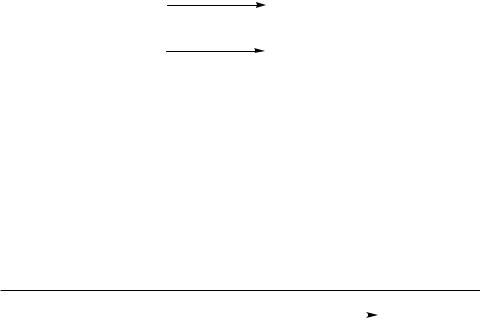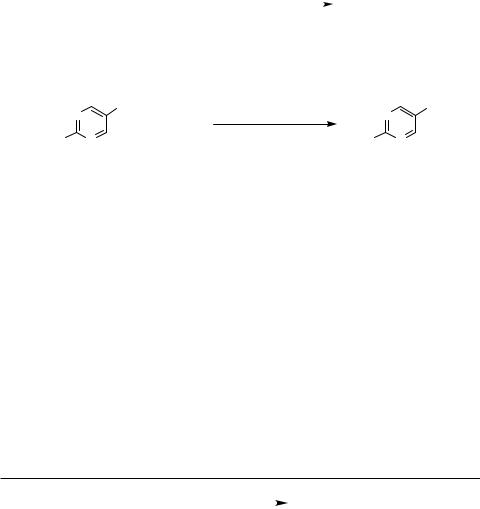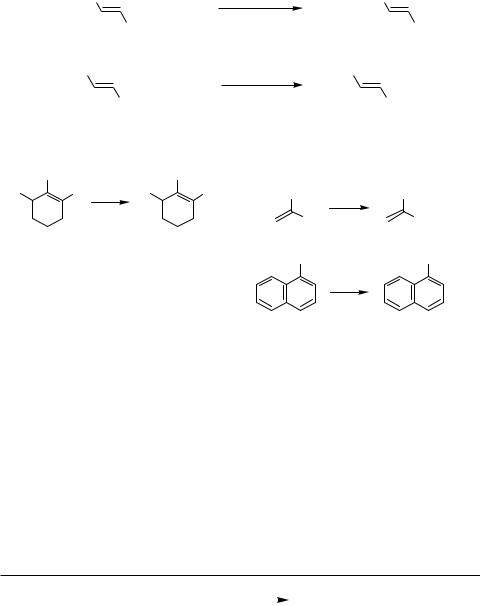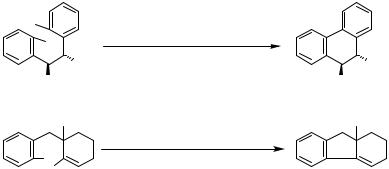

R-Pd-M  R-M + Pd
R-M + Pd
III.3.4 Palladium-Catalyzed Carbon–Metal Bond Formation via Reductive Elimination
AKIRA HOSOMI and KATSUKIYO MIURA
A. INTRODUCTION
In 1973, Atwell and Bokerman reported that, in the presence of palladium or nickel catalysts, certain organic halides (R—X) underwent dehalogenative silylation with disilanes (Si––Si) to give monosilanes (R—Si).[1] Since this finding, catalytic metallation using bimetallic compounds as metal nucleophiles has been studied extensively because it provides a facile route to various functionalized organometallic compounds, which are valuable synthetic intermediates but are less accessible by the traditional methods involving Grignard and organolithium reagents.
This section mainly deals with Pd-catalyzed reactions of aryl, alkenyl, benzyl, alkyl, and acyl electrophiles with metal nucleophiles (M = Si, Ge, Sn, B, and transition metals) leading to carbon – metal bond formation (Scheme 1). Allylic and related metallations are described in Sect. V.2.3.3. The reaction mechanism is generally believed to involve, firstly, oxidative addition of R—X to a Pd(0) species; second, transmetallation of the resulting Pd(II) species with M––M ; and finally, reductive elimination forming R—M and the active Pd(0) species. However, another catalytic cycle via oxidative addition of M—M to Pd(0) species is also proposed.[2]
R X + M M′ |
Pd cat. |
+ M′ X |
R M |
R = aryl, alkenyl, benzyl, alkyl, or acyl; X = Cl, Br, I, OTf, or OP(O)(OR′)2 M, M′ = metal or metallic group
Scheme 1
B. CARBON–SILICON BOND FORMATION
B.i. Reactions of Aryl, Alkyl, and Benzyl Halides
The primary commercial method for producing monomeric organohalosilanes involves the reaction of organic halides with elemental silicon, which provides commercially less
Handbook of Organopalladium Chemistry for Organic Synthesis, Edited by Ei-ichi Negishi ISBN 0-471-31506-0 © 2002 John Wiley & Sons, Inc.
1107

1108 III Pd-CATALYZED CROSS-COUPLING
valuable disilanes of the formula RnSi2Cl6-n as by-products. Atwell and Bokerman showed that the disilanes were converted to the desired monomeric silanes by a Pdcatalyzed reaction with organic halides.[1] Although the reaction is especially effective in the synthesis of allylsilanes, it is applicable to silylation of aryl and alkyl chlorides (Scheme 2). Matsumoto, Nagai, and their colleagues later found that (Me3Si)2 as well as (ClMe2Si)2 and (Cl2MeSi)2 reacted with aryl bromides and chlorides in the presence of Pd(PPh3)4 (1) to give aryltrimethylsilanes, thus developing a new efficient route to functionalized arylsilanes (Table 1). In the dehalogenative silylation, aryl chlorides and iodides are less reactive than the corresponding bromides. The presence of an electron-withdrawing group in the aryl halides considerably accelerates the silylation, which implies a reaction mechanism via oxidative addition to a Pd(0) species. Further studies on the reaction of (Me3Si)2 with aryl and alkyl halides using several Pd(0) and Pd(II) complexes were performed by Eaborn et al.[6]
PhCl or BuCl + (Cl3Si)2
PhCl + (Cl2MeSi)2
10% Pd/C (1 mol %)
200 °C, 74 or 16 h
PhSiCl3 85% or BuSiCl3 88%
as above |
PhSiMeCl2 46% |
200 °C, 24 h |
Scheme 2
Tributyl(trimethylsilyl)stannane (Me3SiSnBu3) as well as (Me3Si)2 can work as a silicon nucleophile.[7] The reaction with aryl bromides gives arylsilanes exclusively (Scheme 3). It has also been reported that the silylstannane behaves as a tin nucleophile under different reaction conditions.[8]
In the presence of 1, benzyl halides undergo the dehalogenative silylation with (ClMe2Si)2 and (Cl2MeSi)2 to give the corresponding benzylchlorosilanes in high yields (Scheme 4).[2],[9] Interestingly, the use of unsymmetrical disilane ClMe2SiSiMeCl2
TABLE 1. Silylation of Aryl Halides[3]
ArX |
|
|
(ClnMe3-nSi)2 |
|
Pd(PPh3)4 (1)a, toluene |
ArSiMe3-nCln |
|||
|
|
|
|
|
|||||
|
|
|
|
|
|
|
|
||
ArXb |
|
Disilane |
Temperature (°C) |
Time (h) |
Yield (%)c |
||||
|
|
|
|
|
|
|
|
||
PhBr |
|
(Me3Si)2 |
140 |
20 |
99 |
||||
PhBr |
|
(ClMe2Si)2 |
140 |
20 |
98 |
||||
PhBr |
|
(Cl2MeSi)2 |
145 |
25 |
62 |
||||
PhCl |
|
(Me3Si)2 |
170 |
30 |
10 |
||||
4-O |
NC H Cld |
(Me Si) |
2 |
140 |
18 |
100e |
|||
2 |
6 |
4 |
3 |
|
|
|
|
|
|
a0.5 mol % of catalyst based on the disilane charged.
bArX/disilane 1.5:1.
cDetermined by GLC. Based on the disilane charged.
dArX/disilane 1:1.5.
eBased on the ArX charged.

III.3.4 Pd-CATALYZED CARBON–METAL BOND FORMATION |
1109 |
resulted in exclusive formation of benzyldichloromethylsilane rather than another possible product, benzylchlorodimethylsilane. Under similar conditions, trimethylsilylation of other benzyl halides than those bearing a 4-cyano group is not successful due to the competitive homocoupling of the halides (Scheme 4).[10]
R Yield (%)
4-RC H Br + |
|
|
|
|
|
1 mol %1 |
|
|
|
|
|
Me |
60 |
|
M SiSnBu |
3 |
|
|
|
4-RC H SiMe |
3 |
Cl |
34 |
||||||
|
|
|
||||||||||||
6 4 |
3 |
|
toluene, 115 °C, 15 h |
6 4 |
|
|||||||||
|
(2 equiv) |
|
|
|
|
|
|
|
MeO |
50 |
||||
|
|
|
|
|
|
|
|
|
|
|
||||
|
|
|
|
|
|
Scheme 3 |
|
|
|
|
|
|
|
|
|
|
|
|
(ClMe2Si)2 (3 equiv), 1 mol % 1 |
|
|
|
|
|
|
|
|||
RC6H4CH2Cl |
|
|
|
mesitylene, 130 °C, 2−3 h |
|
|
RC6H4CH2SiMe2Cl |
|||||||
|
|
|
|
|
|
|
|
|
||||||
R = H, 2-Me, 3-Me, 4-Me, |
|
[2] |
|
|
|
|
|
87–98 % |
|
|||||
|
|
|
|
|
|
|
|
|
|
|
|
|||
2-Cl, 3-Cl, 4-Cl |
|
|
|
|
|
|
|
|
|
|
|
|
||
|
|
|
|
(Cl2MeSi)2 (1−2 equiv), 1 mol % 1 |
|
|
|
|
||||||
|
|
|
|
benzene, 80 °C, 2−10 h |
|
|
RC6H4CH2SiMe2Cl |
|||||||
RC6H4CH2Cl |
|
|
|
[2] |
|
|
|
|||||||
|
|
|
|
|
|
|
|
|
63–97 % |
|
||||
R = H, 3-Me, 4-Me, |
|
|
|
|
|
|
|
|
|
|
||||
|
|
|
|
|
|
|
|
|
|
|
|
|||
2-Cl, 3-Cl, 4-Cl |
|
|
|
|
|
|
|
|
|
|
|
|
||
|
|
(Me3Si)2 (1 equiv) |
|
|
R |
Ar |
Yield (%) |
|||||||
|
|
|
|
H |
Ph |
|
11 |
|||||||
|
|
0.6 mol % Pd(PAr3)4 |
|
|
|
|||||||||
RC6H4CH2Br |
|
|
|
4-NC |
Ph |
|
57 |
|||||||
|
|
|
|
|
RC6H4CH2SiMe3 |
|
|
|
||||||
|
toluene, 140 |
|
|
|
|
|||||||||
|
|
°C |
|
|
4-NC |
4-MeOC6H4 |
98 |
|||||||
|
|
10−65 h, [10] |
|
|
||||||||||
Scheme 4
The Pd-catalyzed reaction of benzylidene chlorides with (ClMe2Si)2 gives stilbene derivatives in high yield.[11] This reductive coupling would proceed through a reaction mechanism involving dehalogenative silylation (Scheme 5).
PhCHCl2 |
(ClMe2Si)2 |
( 1.5 equiv), 0.5 mol % 1 |
(E)-PhCH |
|
CHPh 78% |
|
||||||
|
|
|
|
|
|
|
||||||
mesitylene, 130 °C, 2.5 h |
|
|
||||||||||
|
|
|
|
|
|
|
|
|||||
|
|
|
|
|
|
|
|
|
|
|
|
|
|
|
|
|
|
|
|
|
|
|
|
||
|
PhCHCl(SiM e2Cl) |
|
(PhCHCl)2 |
|
|
PhCH(SiM e2Cl)CHClP h |
|
|||||
|
|
|
|
|
||||||||
|
|
|
|
|||||||||
|
|
|
|
|
Scheme 5 |
|
|
|
|
|
||
|
|
|
|
|
|
|
|
|
|
|||
B.ii. Reactions of Vinyl Halides and the Related Compounds
Pd-catalyzed silylation of vinyl halides with chloro(methyl)disilanes is valuable for the synthesis of vinylsilanes (Scheme 6).[12]

1110 |
III |
Pd-CATALYZED CROSS-COUPLING |
|
||
|
Ph |
|
(Cl3-nMenSi)2 |
(1.1 equiv) |
Ph |
|
|
0.5 mol % 1 |
|
||
|
|
|
|
|
|
|
|
Br |
neat, reflux, 1 h |
SiMenCl3-n |
|
|
|
|
|
||
|
Cl |
|
(Cl3-nMenSi)2 (2.1 equiv) |
Cl3-nMenSi |
|
|
|
0.3 mol % 1 |
|
||
|
|
Cl |
neat, 180 °C, 15 h |
SiMenCl3-n |
|
|
|
|
|
||
Scheme 6
n = 1, 85% n = 2, 83%
n = 1, 85% n = 2, 83% E/Z = 9:1
In the presence of 1, (Me3Si)2 activated by a fluoride ion from TASF smoothly reacts with vinyl iodides at room temperature (r.t.), affording the corresponding trimethylvinylsilanes in moderate to high yields with stereochemical retention (Scheme 7).[13] This method is applicable to the preparation of aryltrimethylsilanes from aryl iodides. Bimetallic compounds having Si—Al and Si—Mg bonds can also be utilized for Pd-catalyzed silylation of vinyl electrophiles (Scheme 8).[14],[15]
R |
[I] |
R |
R |
I |
[I] |
|
R |
SiMe3 |
|
|
|||||||
|
[13] |
SiMe3 |
|
|
[13] |
|
|
|
|
I |
|
|
|
|
|
|
|
R, Yield (%): Ph, 82; n-Hex, 74; NC(CH2)9, 53; |
|
R, Yield (%): Ph, 84; n-Hex, 62 |
||||||
|
MeOOC(CH2)8, 92 |
|
|
|
|
|
|
|
[I] = (Me3Si)2 (1.3 equiv), TASF (1.2 equiv), 5 mol % 1, THF-HMPA, r.t., 2−15 h
Scheme 7
n-Pent |
[II] n-Pent |
|
[14] |
I |
SiMe3 |
|
83% |
O |
|
|
OP(OPh)2 |
[III] |
SiMe2Ph |
|
|
[15]
n-Hex n-Hex
PhMe2SiAlEt2: 55%
PhMe2SiMgMe: 74%
[II] = (Me3Si)3Al (1.2 equiv), 5 mol % 1, Et2O-pentane, r.t., 4 h
[III]= PhMe2SiAlEt2 or PhMe2SiMgMe (3 equiv.), Pd(OAc)2 (0.1 equiv), P(4-Tol)3 (0.4 equiv), hexane, r.t., 1 h or 0.5 h
Scheme 8
B.iii. Reaction of Acyl Halides
A direct preparative route to aroyltrimethylsilanes is provided by the Pd(II)-catalyzed reaction of aroyl chlorides with (Me3Si)2 (Table 2).[6],[16]–[18] The combination of [( 3- C3H5)PdCl]2 (2) with P(OEt)3 is much more effective for this particular reaction than 1.

|
|
III.3.4 |
Pd-CATALYZED CARBON–METAL BOND FORMATION |
1111 |
||||||
TABLE 2. Reaction of Aroyl Halides[17] with (Me3Si)2a |
|
|
|
|
||||||
|
|
|
|
|
|
|
|
|
|
|
RC6H4COCl |
(Me3Si)2 |
|
|
catalyst |
RC6H4COSiMe3 |
|
RC6H4SiMe3 |
|||
|
|
|
|
|||||||
|
|
neat |
||||||||
|
|
|
|
|
|
|
|
|
||
|
|
|
|
|
|
|
|
|
||
|
|
|
|
|
Yield of Acylsilane (%) (Arylsilane (%)) |
|
|
|||
|
|
|
|
|
|
|
|
|
|
|
|
R/H |
Me |
MeO |
Cl |
CO2Me |
|
NO2 |
|||
|
|
|
|
|
|
|
|
|
|
|
2-Substituent |
|
|
24 |
32 |
24 (11) |
— (36) |
|
— (30) |
||
3-Substituent |
|
|
48 |
47 |
57 |
56 |
|
43 |
||
4-Substituent |
78 (3) |
81 |
48 |
71 |
45 (5) |
|
37 (28) |
|||
|
|
|
|
|
|
|
|
|
|
|
aConditions: (Me3Si)2 (1.1 equiv), 2.5 mol % [( -C3H5)PdCl]2 (2), and 10 mol % P(OEt)3 at 110 °C for 3–20 h.
The ligand employed, P(OEt)3, effects the successful catalytic reaction by retarding the competitive decarbonylation leading to arylsilanes. The reaction of aliphatic acid chlorides with (Me3Si)2 resulted in rather low yields of the corresponding acylsilanes. However, the use of Me3SiSnBu3 works well for the preparation of aliphatic acylsilanes (Scheme 9).[19]
|
|
|
|
R |
Time |
Yield (%) |
|
Me3SiSnBu3 (1.2 equiv) |
|
|
|
|
|
|
|
n -Bu |
20 min |
63 |
||
|
5 mol %2, 10 mol % P(OEt)3 |
|
||||
|
|
|
|
|
||
|
neat, 110 °C |
|
n -Hept |
16 h |
74 |
|
RCOCl |
|
|
RCOSiMe3 |
|
|
|
[19] |
|
20 min |
66 |
|||
|
|
|
Ph |
|||
Scheme 9
In contrast, the reaction of aroyl chlorides with (ClMe2Si)2 and (Cl2MeSi)2 gives only arylchloromethylsilanes in the presence of (PhCN)2PdCl2•2PPh3, which catalyzes the reaction with (Me3Si)2 forming aroyltrimethylsilane exclusively (Scheme 10).[20]–[22] The substrates bearing an electron-withdrawing group on the aromatic ring are reactive toward the silylative decarbonylation. The silylation of aliphatic acyl chlorides does not proceed at all because of fast Pd-catalyzed -hydrogen elimination.
|
(ClMe2Si)2 (1−1.3 equiv) |
|
R Yield(%) |
R Yield(%) |
|||
|
|
H |
89 |
3-MeO |
71 |
||
|
0.5−1 mol % (PhCN)2PdCl2 |
|
|||||
|
|
2-Me |
13 |
4-MeO |
|
||
|
1−2 mol % PPh3 |
|
52 |
||||
RC6H4COCl |
neat, 145 °C, 20 h |
RC6H4SiMe2Cl |
3-Me |
47 |
3-O2N |
74 |
|
[20] |
|
4-Me |
58 |
4-O2N |
72 |
||
|
|
|
|
||||
Scheme 10
C. CARBON–GERMANE BOND FORMATION
Digermanes are also available for Pd-catalyzed metallation of aryl and acyl halides.[10],[17] In the latter metallation, silylgermanes mainly behave as germane nucleophiles (Scheme 11).

1112 |
III Pd-CATALYZED CROSS-COUPLING |
|
|
|
|
||||
|
|
|
(Et3Ge)2 (1 equiv), 0.6 mol % 1 |
|
|
|
|
||
|
4-MeC6H4Br |
|
toluene, 140 °C, 90 h |
|
4-MeC6H4GeEt3 |
+ |
(4-MeC6H4)2 |
||
|
[10] |
|
|
||||||
|
|
|
|
|
35% |
|
60% |
||
|
|
|
|
|
|
|
|
||
|
|
(Me3Ge)2 or Me3SiGeMe3 (1.1 equiv) |
|
|
|
|
|||
|
|
5 mol % 2, 10 mol % P(OEt)3 |
|
|
|
|
|||
|
PhCOCl |
neat, 110 °C, 4−4.5 h |
|
PhCOGeMe3 |
+ |
PhCOSiMe3 |
|||
|
[17] |
|
|
|
|||||
|
|
|
|
|
78% |
|
|
||
|
|
|
(Me3Ge)2: |
|
|
||||
|
|
|
Me3SiGeMe3: |
37% |
|
7% |
|||
Scheme 11
D. CARBON–TIN BOND FORMATION
D.i. Reactions of Aryl and Benzyl Halides
Pd-catalyzed stannylation of organic halides with distannanes was first reported by Eaborn and co-workers in 1976.[10] They observed that treatment of a 1:1 mixture of aryl halides and distannanes ((Bu3Sn)2 or (Me3Sn)2) with 1 in toluene at 140 °C gave arylstannanes and biaryls, and in some cases, only biaryls. The reaction conditions were later improved by themselves and other groups. Thus, it has been disclosed that an excess amount of distannanes is effective in suppressing the formation of biaryls and increasing the yields of arylstannanes.[7],[23] The results of the stannylation of various aryl halides with 2 equiv of distannanes are summarized in Table 3.[7] In contrast to the trimethylsilylation of aryl halides, aryl iodides are as reactive as aryl bromides, and the presence of an electron-withdrawing group on the aromatic ring is not effective in the stannylation due to the formation of biaryls. The tributylstannylation of 4-bromonitrobenzene does not proceed at all; however, under somewhat different conditions, the desired product can be obtained in a moderate yield.[23]
TABLE 3. Stannylation of Aryl Halides[7] with Distannanes a
|
RC6H4X |
|
|
(R 3Sn)2 |
catalyst |
RC6H4SnR 3 |
|
|
||||
|
|
|
|
|
|
|
||||||
|
|
|
|
|
|
|
||||||
|
|
|
|
|
|
|
|
|
|
|
|
|
R |
X |
R |
Catalyst |
Yield (%) |
R |
X |
R |
Catalyst |
Yield (%) |
|||
|
|
|
|
|
|
|
|
|
|
|
|
|
H |
Br |
Bu |
|
1 |
79 |
|
4-NC |
Br |
Bu |
3 |
57 |
|
H |
Br |
Bu |
|
3 |
75 |
|
4-MeCO |
Br |
Bu |
1 |
57 |
|
H |
I |
Bu |
|
1 |
96 |
|
3-O2N |
Br |
Bu |
3 |
35 |
|
H |
I |
Bu |
|
3 |
94 |
|
H |
I |
Me |
3 |
96 |
|
H |
Cl |
Bu |
|
1 |
0 |
|
4-Me |
I |
Me |
3 |
86 |
|
4-Me |
Br |
Bu |
|
1 |
75 |
|
4-MeO |
I |
Me |
1 |
96 |
|
2-Me |
Br |
Bu |
|
1 |
64 |
|
4-NC |
Br |
Me |
1 |
64 |
|
4-MeO |
Br |
Bu |
|
1 |
81 |
|
4-MeCO |
Br |
Me |
1 |
56 |
|
4-Cl |
Br |
Bu |
|
1 |
59 |
|
4-O2N |
Br |
Me |
1 |
37 |
|
3-Cl |
Br |
Bu |
|
1 |
73 |
|
3-O2N |
Br |
Me |
1 |
31 |
|
aConditions: aryl halide (1 equiv), distannane (2 equiv), and 1.3 mol % Pd(PPh3)4 (1) or PdBr2(PPh3)2 (3) in toluene at 115 °C for 15 h.

III.3.4 Pd-CATALYZED CARBON–METAL BOND FORMATION |
1113 |
Beletskaya and co-workers have reported that trimethylstannylation of aryl iodides bearing an electron-withdrawing group with a small excess of (Me3Sn)2 is effectively promoted at 20 °C by 2[24],[25] or (MeCN)2PdCl2.[26] Activation of distannanes with TBAF also achieves Pd-catalyzed stannylation of aryl bromides at r.t.
(Scheme 12).[27],[28]
RC6H4I + |
(Me3Sn)2 |
2 mol % (MeCN)2PdCl2 , DMF |
RC6H4SnMe3 |
|
[26] |
|
|||
|
(1.2 equiv) |
|
|
|
|
|
|
|
|
R = 4-MeO2C, 4-Ac, 4-NC, 2-, 3-, and 4-O2N: 20 °C, 5−15 min, 95−100 % |
||||
R = 4-MeO: 50 °C, 80 min, 74% |
|
|
|
|
N |
Br |
3 mol % 2, TBAF (1 equiv) |
SnR3′ |
|
+ (R3′Sn)2 |
THF, r.t., 4 h |
N |
||
|
[28] |
|
|
|
MeS N |
(2 equiv) |
|
MeS N |
|
|
|
|||
R′ = Bu and Me: 72% and 74%
Scheme 12
As described in Table 4, Pd-catalyzed stannylation is accessible to a range of benzylstannanes with some exceptions.[7]
D.ii. Reactions of Vinyl Halides and Triflates
Pd-catalyzed reaction of -bromostyrene with (Bu3Sn)2 gives -styrylstannane in a rather low yield.[7] An efficient dehalogenative stannylation of vinyl halides is observed only for electron-deficient ones. -Chloro- , -unsaturated sulfoxides, sulfones, and esters smoothly react with (Me3Sn)2 in NMP at r.t. by the aid of a Pd catalyst (Scheme 13).[29]
Vinyl triflates can easily be converted to the corresponding vinylstannanes by reaction with (Me3Sn)2 using the catalytic system originally developed by Stille and colleagues (Scheme 14).[30],[31] Aromatic triflates also undergo the stannylation to form arylstannanes.
TABLE 4. Stannylation of Benzyl Halides[7] with Distannanes a
|
RC6H4CH2X |
(R 3Sn)2 |
|
catalyst |
RC6H4CH2SnR 3 |
|
||||||
|
|
|
|
|
|
|||||||
|
|
|
|
|
|
|||||||
|
|
|
|
|
|
|
|
|
|
|
|
|
R |
X |
R |
Catalyst |
Yield (%) |
|
R |
X |
R |
Catalyst |
Yield (%) |
||
|
|
|
|
|
|
|
|
|
|
|
|
|
H |
Br |
Bu |
3 |
76 |
|
|
3-O2N |
Br |
Bu |
3 |
30 |
|
H |
Cl |
Bu |
1 |
95 |
|
|
3-Cl |
Br |
Me |
1 |
65 |
|
4-MeO |
Cl |
Bu |
1 |
35 |
|
|
3-NC |
Br |
Me |
1 |
95 |
|
3-Cl |
Cl |
Bu |
3 |
58 |
|
|
4-NC |
Br |
Me |
1 |
96 |
|
3-NC |
Br |
Bu |
3 |
56 |
|
|
3-O2N |
Br |
Me |
1 |
68 |
|
|
|
|
|
|
|
|
|
|
|
|
|
|
aConditions: benzyl halide (1 equiv), distannane (2 equiv), and 1.3 mol % Pd(PPh3)4 (1) or PdBr2(PPh3)2 (3) in toluene at 115 °C for 15 h.

1114 |
III Pd-CATALYZED CROSS-COUPLING |
|
||
|
4 -RC6H4SOn |
|
1 mol % Pd2dba3 |
4 -R C6H4SOn |
|
|
8 mol % PPh3 |
||
|
+ (Me3Sn)2 |
|
||
|
NMP, r.t., 0.7−4 h |
|
||
|
Cl |
(2.2 equiv) |
Sn Me3 |
|
|
|
|||
|
|
|
R = H, O2N, F3C; n = 1−2: 47−84% |
|
|
BnO2C |
(Me3 Sn)2 |
as above |
BnO2C |
|
+ |
NMP, r.t., 16 h |
|
|
|
Cl |
(1.3 equiv) |
Sn Me3 |
|
|
|
|||
|
|
|
|
61% |
Scheme 13
|
|
|
OTf |
|
|
SnMe3 |
R |
1 |
|
2 |
1 |
2 |
|
|
|
|
R |
R |
R |
|
|
|
|
|
[30] |
|
|
|
|
R1 |
R2 |
Conditions Time (h) Yield (%) |
||
|
|
H |
H |
[I] |
3 |
81 |
|
|
Me |
H |
[I] |
9 |
84 |
|
|
H |
Me |
[II] |
168 |
80 |
|
|
Me |
Me |
[II] |
120 |
62 |
[I] = (Me3Sn)2 (0.9 equiv), LiCl (6 equiv), 1.8 mol % [II] = 5 mol % 1 in [I], Li2CO3 (1 equiv)
Scheme 14
OTf |
[I] |
SnMe3 |
n-Hex |
|
n-Hex |
|
|
6 h, 74% |
OTf |
|
SnMe3 |
|
[I] |
|
168 h, 86%
1, THF, 60 °C
D.iii. Reaction of Acyl Halides
Pd-catalyzed stannylation of acyl halides with (Me3Sn)2 provides a convenient route to acyltrimethylstannanes (Table 5).[32],[33] This method is not effective in the synthesis of other acyltrialkylstannanes[34] since they are highly reactive to acyl halides in the presence of the Pd catalyst and rapidly turn into symmetric -diketones and ketones.[35]–[37]
TABLE 5. Stannylation of Acyl Chlorides[33] with (Me3Sn)2a
RCOCl |
|
(Me3Sn)2 |
|
catalyst |
RCOSnMe3 |
|
||||
|
|
|
|
|
||||||
|
|
|
|
|
||||||
|
|
|
|
|
|
|
|
|
|
|
R |
Condi- |
|
|
|
|
|
|
Condi- |
|
|
|
tions |
Time(h) |
Yield (%) |
|
R |
tions |
Time (h) |
Yield (%) |
||
|
|
|
|
|
|
|
|
|
|
|
Me |
[I] |
12 |
70 |
|
|
Ph |
[I] |
12 |
80 |
|
Et |
[II] |
18 |
70 |
|
|
2-MeC6H4 |
[III] |
16 |
75 |
|
t-Bu |
[III] |
16 |
80 |
|
|
4-MeC6H4 |
[II] |
14 |
64 |
|
(E)-PhCH"CH |
[I] |
12 |
80 |
|
|
4-MeOC6H4 |
[III] |
30 |
54 |
|
aConditions: RCOCl (1 equiv), (Me3Sn)2 (1 equiv), and [I] – [III]. [I]: 5 mmol % 1 in THF at reflux; [II]: 5 mmol % BnPdCl(PPh3)2 in THF at reflux; [III]: 5 mmol % PdCl2(PPh3)2 in toluene at 100 °C.

III.3.4 Pd-CATALYZED CARBON–METAL BOND FORMATION |
1115 |
D.iv. Palladium-Catalyzed Reductive Coupling
As described in Sect. III.2.3, the coupling between organostannanes and carbon electrophiles can effectively be catalyzed by Pd complexes. Thus, in some cases, the organostannanes generated by the Pd-catalyzed reaction of carbon electrophiles with distannanes further react with unreacted carbon electrophiles to form homocoupling products such as biaryls (from aryl halides), -diketones, and ketones (from acyl halides) as mentioned above. Although this type of reductive coupling is undesirable for an efficient and selective formation of carbon–metal bonds, it provides a useful synthetic method of some organic compounds, particularly cyclic ones (Scheme 15).[8],[38]–[40]
X |
(Me3Sn)2 (1.2 equiv), 5−20 mol % 1 |
|
||
X |
0.1 M in dioxane, 100−105 °C, 24 h |
|
||
OH |
[39] |
X = Br, 80% |
OH |
|
|
X = I, 87% |
|||
OH |
|
OH |
||
|
|
|||
CO2Et |
Me3SiSnBu3 (1.1 equiv), 3 mol % 1 |
CO2Et |
||
Bu4NBr (3 equiv), Li2CO3 (1 equiv) |
||||
|
|
|||
|
0.1 M in toluene, 110 |
°C, 1.5 h |
|
|
Br |
[8] |
|
|
|
TfO |
|
|
70% |
|
|
|
|
||
Scheme 15
E. CARBON–BORON BOND FORMATION
The Pd-catalyzed cross-coupling reaction of the pinacol ester of diboronic acid with aryl halides and triflates gives a direct procedure for various functionalized arylboronic esters (Table 6),[41],[42] which are useful for highly efficient and selective carbon–carbon bond formation by Pd catalysts (Sect. III.2.2). The combination of PdCl2(dppf ) with KOAc (and dppf) is effective in the carbon–boron bond formation. KOAc is essential not only to accelerate the reaction but also to prevent the formation of biaryl by-products.
F. CARBON–TRANSITION METAL BOND FORMATION
F.i. Reactions of Aryl and Vinyl Halides with Metal Carbonylates
Pd-catalyzed metallation of carbon electrophiles is also applicable to carbon–transition metal bond formation. Beletskaya and colleagues have reported that, in the presence of a Pd(II) catalyst, zinc salts of metal (Fe, Re, W, and Mn) carbonylates smoothly react with aryl and vinyl halides to afford the corresponding 1-aryl and 1-vinyl complexes (Table 7 and Scheme 16).[43]–[46] The metallation of vinyl halides proceeds with stereochemical retention as in the case with other metal nucleophiles. The use of alkali salts of the metal carbonylates considerably reduces the yields of coupling products.

1116 |
III Pd-CATALYZED CROSS-COUPLING |
|
|
|
|
|
|||
TABLE 6. Borylation[41],[42] of Aryl Halides and Triflatesa |
|
|
|
||||||
|
|
O |
O |
[I] for halides |
|
|
O |
||
|
|
[II] for triflates |
|
|
|||||
4-RC6H4X + |
B B |
|
4-RC6H4 B |
|
|||||
|
|
|
O |
||||||
|
|
O |
O |
|
|
|
|
||
|
|
|
|
|
|
|
|
|
|
R |
X |
Time (h) |
Yield (%) |
|
R |
X |
Time (h) |
Yield (%) |
|
|
|
|
|
|
|
|
|
|
|
H |
Br |
2 |
98 |
|
MeO |
OTf |
13 |
93 |
|
Me2N |
I |
6 |
90 |
|
MeS |
OTf |
24 |
81 |
|
MeO |
I |
2 |
82 |
|
OHC |
OTf |
17 |
91 |
|
Ac |
Br |
1 |
80 |
|
Ac |
OTf |
6 |
92 |
|
MeO2C |
Br |
1 |
86 |
|
MeO2C |
OTf |
21 |
80 |
|
NC |
Br |
1 |
76 |
|
NC |
OTf |
15 |
75 |
|
O2N |
Br |
2 |
86 |
|
O2N |
OTf |
6 |
86 |
|
Br |
I |
1 |
86 |
|
|
|
|
|
|
|
|
|
|
|
|
|
|
|
|
aConditions: aryl halides or triflates (1 equiv), diboron (1.1 equiv), and [I] for halides or [II] for triflates at 80 °C. [I]: 3 mol % PdCl2(dppf) and KOAc (3 equiv) in DMSO. [II]: 3 mol % PdCl2(dppf), 3 mol % dppf, and KOAc (3 equiv) in dioxane.
Ph |
H |
[I] |
Ph |
H |
Ph |
Br [I] |
Ph |
Fe(CO)2Cp |
|
H |
Br |
[46] |
H |
Fe(CO)2Cp |
H |
H |
|
H |
H |
|
|
|
|
60% |
|
|
|
|
50% |
[I]: ZnCl[Fe(CO)2Cp] (1.3−1.4 equiv), 1.2−2.1 mol % PdCl2(PPh3)2, THF, −78 to 20 °C, 0.5−1.5 h
Scheme 16
In contrast to the above reaction, the Pd-catalyzed coupling of K[Co(CO)4] with aryl iodides in the presence of PPh3 gives aroylcobalt complexes (Scheme 17).[47]
F.ii. Reaction of Metal Iodides with Alkynylstannanes
Lo Sterzo and co-workers have disclosed that the coupling between metal iodides and alkynylstannanes can be promoted by (MeCN)2PdCl2 (Scheme 18).[48]–[52] This is a fairly
TABLE 7. Metallation[44] of Aryl Iodides with Zn[M(CO)nL]2a
4-RC6H4I |
|
Zn[M(CO)nL]2 |
1 mol % PhPdI(PPh3)2 |
4-RC6H4M(CO)nL |
||||
|
THF, 20 °C |
|||||||
|
|
|
|
|
|
|
|
|
|
|
|
|
|
|
|
|
|
R |
M(CO)nL |
|
Time (h) |
Yield (%) |
R |
M(CO)nL |
Time (h) |
Yield (%) |
|
|
|
|
|
|
|
||
H |
Fe(CO)2Cp |
1 |
68 |
CH3CO Fe(CO)2Cp |
1 |
62 |
||
CH3 |
Fe(CO)2Cp |
0.75 |
69 |
CH3 |
Re(CO)5 |
0.75 |
65 |
|
Cla |
Fe(CO)2Cp |
0.66 |
55 |
CH3 |
W(CO)3Cp |
0.66 |
86 |
|
CNa |
Fe(CO)2Cp |
0.66 |
64 |
CH3 |
Mn(CO)5 |
3.5 |
62 |
|
ap-O2NC6H4PdI(PPh3)2 was used as Pd catalyst.
